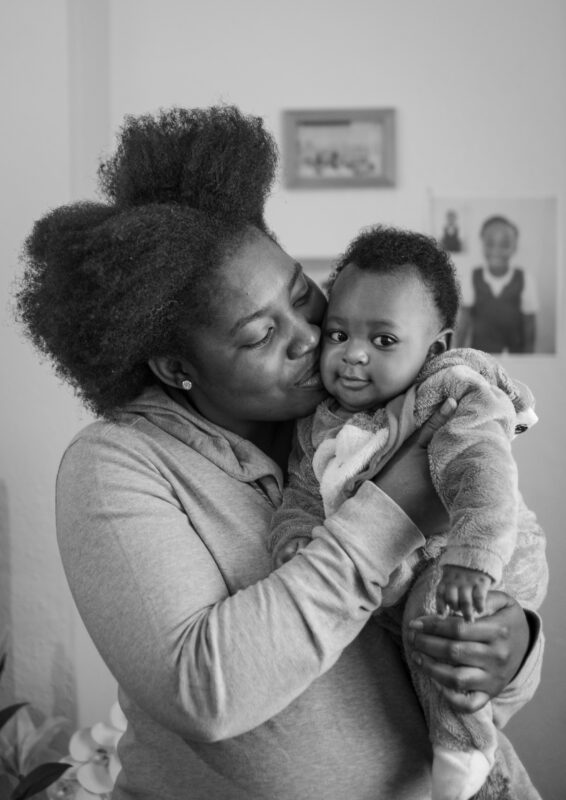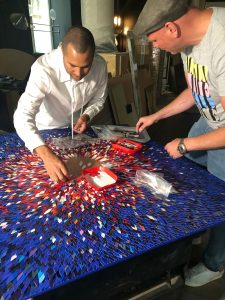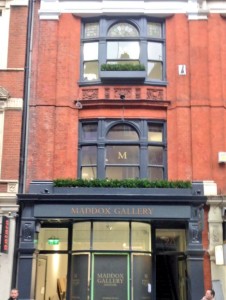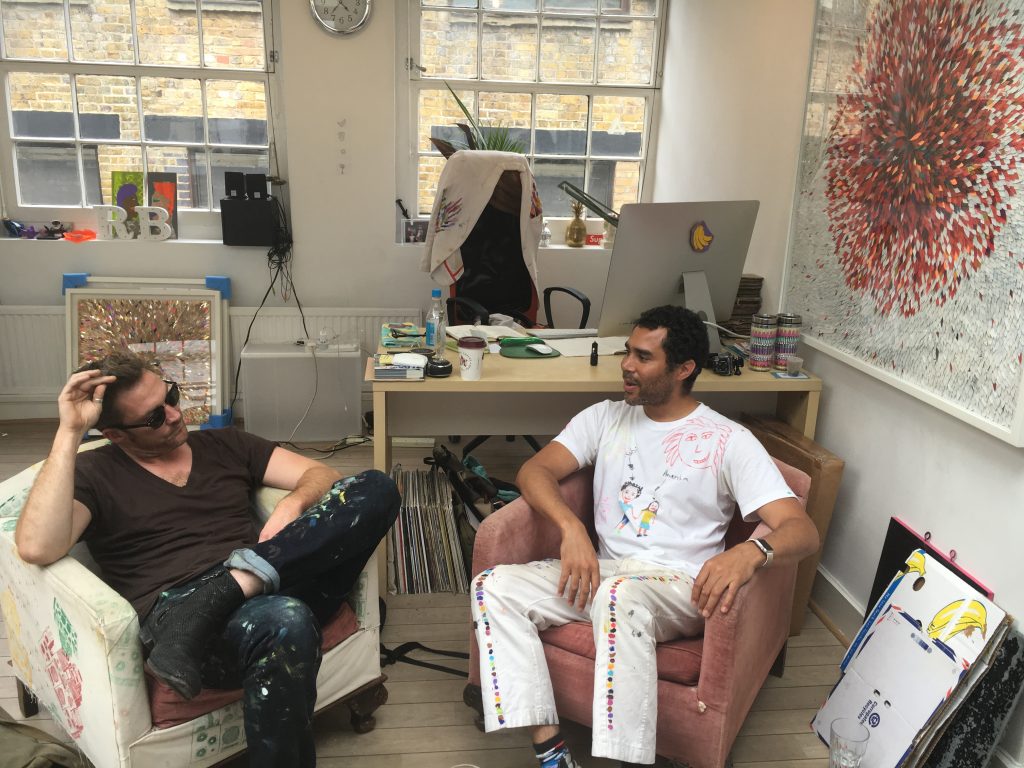
Disseverance celebrates the rapport of two very distinct artistic narratives, exploring the co-existence of opposites and more specifically, how they interact. Here, Robi Walters and Chris Moon talk to FAD about their very different creative processes, producing two separate bodies of work, together, and what they do when they aren’t creating their art.
RW: What have you found as the challenge when producing a body of work to be shown alongside another body of work?
CM: I imagine the two bodies of work next to one another, and try and take everything back to the basic elements of painting. It’s about creating an initial impact and a voice between the two bodies of work. There are two stories, and it’s important to create a happy middle ground where the works can co-exist. When we curate this show, the two bodies of work will all come together. At the moment we are faced with a white space, so it can be challenging to imagine the two bodies of work at the final stage of exhibition. The curation of the work plays an important role in bringing the two bodies together.
Now I’ve seen your work today, I’m buzzed about finishing mine, so it plays off. The discussion and involvement with each other’s work, and processes can be really important too.
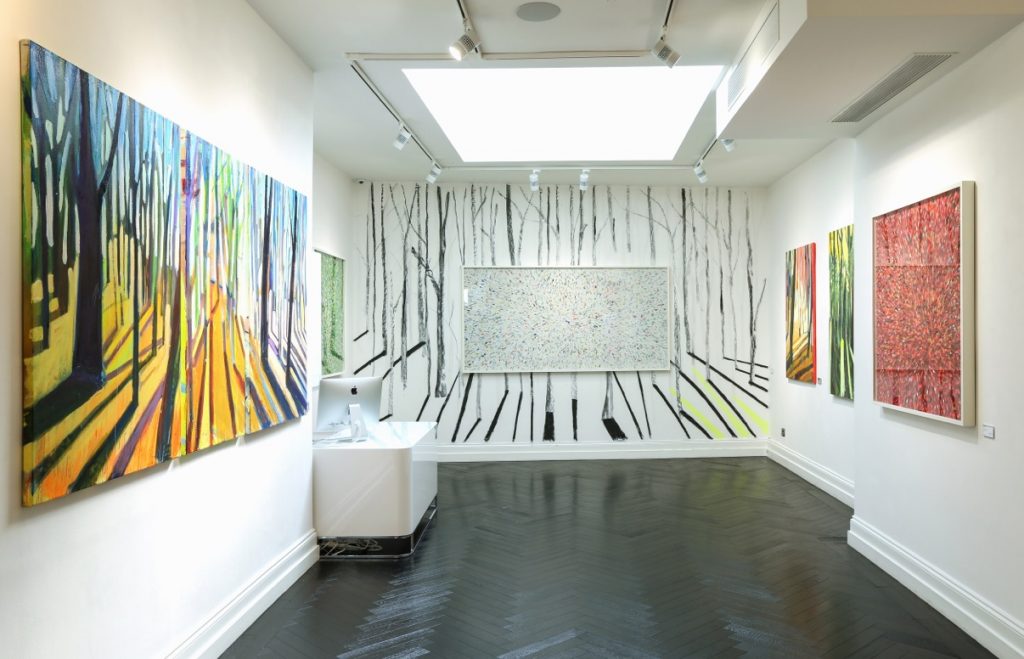
RW: How do you feel about work that you’ve created by the coast, out of town, showing in London. Has surfing, the sea etc. inspired you?
CM: It has been therapeutic. I want the work to have that human narrative. This work is in no way the story of the beauty of a forest, that just wouldn’t work, pretty paintings of a wood. I don’t want the work to be purely about painting and seen as something decorative. It’s more a human response to light and shadow and of a process that mirrors life and an emotional sense. It’s about what lies beneath, not what is seen but what hides and what we keep hidden.
RW: What has been your start point?
CM: This story starts while I was in the middle of creating a body of work based in and around a studio I found myself in Epping. The house is nestled within Epping Forest and I was making studies from Christmas of the previous year till the next. I was then offered the chance to show with you and straight away the architecture of the woods’ studies came to mind as a fit. To sit not entirely comfortably with your work but, in a way right.
The studies I selected were of a stripped back scene when no foliage was present, in a way the personality of the woods laid bare. This would allow me to tell any seasonal change or story with colour and push the essence of invading light, the bare bones of the structure sparked my initial buzz. The simple mark making of the sketches would give me an opportunity to get back to basics where simple mark making can provide a big impact. Pushing the basics of painting; light, shadow, colour and form in painting I find techniques to tell a story and this work is in no way the story of the beauty of a forest, that just wouldn’t work, pretty paintings of a wood. It’s more a human response to light and shadow and of a process that mirrors life and an emotional sense. It’s about what lies beneath, not what is seen but what hides and what we keep hidden.
CM: What’s yours?
RW: I started the collage pieces in 2009 after watching a documentary called Zeitgeist, which questioned the systems of control/power in our society (namely money, war and religion). It was the first time I had seen anything like this and it had a huge impact on me. I didn’t have access to conventional art supplies at the time, so looked around me for things to utilise. The overflowing recycling box in my kitchen triggered me to start exploring the impact of human consumerism and consumption. But I didn’t want to present solely a negative critique. Instead, I wanted to take something as ugly as garbage and transform it into something beautiful without losing the core message. Inspired by sacred geometry and my daily meditation practice, I took the card packaging from my recycling bin and cut them into petal shapes to create a larger image representing a thousand petalled lotus. The lotus is related to the chakra system, which are spinning colours of light in different energetic locations of the human spine. I’m taking everyday waste and turning it into something that to me represents the connection between the physical world and the infinite. The thousand petalled lotus grows up through the dark, stagnant, muddy swamp to reach the light of the surface to bloom. The colours of each chakra have influenced the colour palette for the work in Disseverance.
RW: Do you use your work as therapy for anxiety?
CM: Yes, I definitely bring my anxiety into my work as a way of pushing it out. That’s why I paint. You make a piece and hide behind it.
RW: The colours of each chakra have influenced my colour palette for the work in Disseverance. In terms of your colour palette – are these colours you’ve always used or new colours?
CM: I’ve dipped my toe into a new palette, but I’ve also been considering your work and colour palette, and been trying to balance and play with the two.
RW: When you finish a piece are you ever happy with it?
CM: I never have been really. The grass is always greener, isn’t it? It’s a little dram of a bigger bottle. I always get into the trap of thinking, “Is this what people will judge me on, is this the last show, is it any good?” I think this is quite a natural path for an artist to follow. What do you think?
RW: Though our work is physically quite different, I see this exhibition as a celebration of the communion of polarities, I think our processes and attitude towards our work is quite similar. We are both emotionally engaged in what we produce, how we talk about it and share it.
RW: Do you ever get emotionally attached to a piece and not want to sell it?
CM: Yeah, you do get attached to it. It’s like a relationship. It starts fun, messy, exciting, then after time gets boring and ends in divorce. Then you look back and think ’that was alright’ Do you feel the same way?
RW: Yes, totally. Though I find it interesting as my initial, creative process almost works in the opposite way. I work by taking something seen as boring, everyday waste and turning it into something exciting, that to me, represents the connection between the physical world and the infinite.
RW: What happens to time when you are painting. Does time stop and fly by?
CM: For me its all about using my time and finding something on that journey. With a lot of my work I find a technique to visually convey narrative and tell a story. This is often the most personal work I’ve done.
RW: When you say it’s your most personal, do you feel vulnerable showing it?
CM: Not especially, that’s just part of human nature. When all this is said and done and I discard it, it’s left to the viewer and they can make their decision.
RW: What do you do to relax?
CM: I surf. I wouldn’t say I was churning paintings out, but there was a stage when I was painting when I didn’t want to be. So surfing was the chance I had to go and relax, surfing was great for me to relax. People with mental health disorders, anxiety, depression, should all go on surf camps. Up at 6 am, in the ocean, breakfast then back into the ocean. Some days it was just 5 hours a day of pure surfing. You can’t have booze, you have one drink in the evening and it just sends you straight to sleep. Its just so nice, it completely revitalizes you. So that’s what we should do, we should open Surf camps for the mentally ill.
When I started selling work, my painting, I wanted more action in my painting. If you’re doing detailed work, your spending hours painting. Things are inevitably going to start going wrong if you’re just doing that and constantly overthinking everything. That’s why I like surfing, as you don’t think of anything else out there, except survival!
RW: Did you learn how to surf as a kid?
CM: As a kid I thought it was cool and I made it a thing I always wanted to learn. You need something like that. I was always active before. How do you relax, and keep active? Robi?
RW: Walking, cycling and daily meditation. I’m very inspired by sacred geometry and my daily meditation practice. The lotus flower you see as a recurrent theme in my work is related to the chakra system, the spinning colours of light in different energetic locations of the human spine. So I would say I meditate to relax, but it also plays a big part in my work as one of the key concepts.
Also spending time with my kids keeps me very active! All ages, thirteen, ten and two and a half. They’re great I love them.
CM: Is it nice having your kids perspective on your work? As kids can be the best critics, so blunt, they just come out with it, that’s good or that’s bad.
RW: Yes agreed, there’s no hesitation, just direct opinion and criticism. My ten-year-old daughter is brilliant. If I need any advice, I know I’m going straight to her.
Chris Moon & Robi Walters, Disseverance is at Maddox Gallery 9 Maddox Street London W1S 2QE. From 16th -30th September.
Instagram: @maddoxgallery @robiwalters @chrismoonart
